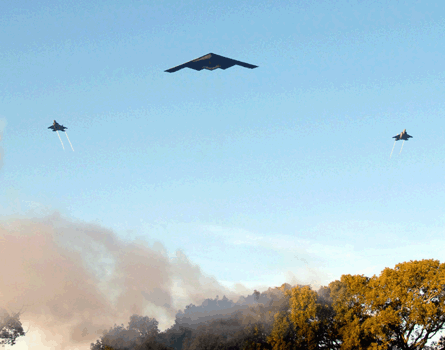The US Air Force has cleared a five-year upgrade project to allow the Lockheed Martin F-22A Raptor to communicate with other stealthy - and perhaps some non-stealthy - aircraft types. The project will cost roughly $900 million.
Integrating the Multifunction Advanced Data Link (MADL) by 2015 should solve two embarrassing gaps in the USAF's airborne network. The F-22 lacks a multi-platform datalink and F-22 and Lockheed F-35 Joint Strike Fighter pilots would be unable to talk or share information with each other.
Michael Therrian, chief of the USAF's Electronic Systems Center's airborne networking division, says the fledgling MADL integration effort has helped bridge a cultural divide between F-35 and F-22 programmes within Lockheed.
"Lockheed Martin is now realising that there is a strong need to talk to each other and share information," Therrian says. "Before it was, 'I've just got my programmes', and now they're starting to talk to each other."
 |
|---|
© USAF Lt. Col. Sandy Burr |
The MADL was designed specifically to support the F-35, with six antennas providing spherical coverage around the aircraft.
ESC's programme office for MADL completed a study last month that confirmed the waveform can be adapted for the F-22, although there remains "some risk involved", Therrian says.
That means the MADL will become the first waveform with low-probability of intercept/low-probability of detection capability and installed on more than one aircraft type. The USAF also plans to integrate MADL on the Northrop B-2A bomber fleet.
MADL was selected by the USAF after the Office of the Secretary Defense intervened last year. The USAF performed an analysis of alternatives that considered every waveform in existence or development.
As part of that study, the USAF rejected the Rockwell Collins Tactical Targeting Network Technology (TTNT), a wideband, internet protocol-based messaging standard, for the stealth fleet. The TTNT was rejected because its signal could be detected.
Lockheed's MADL is a Ku-band datalink that is unlikely to be intercepted or detected by the enemy. While Link 16 or TTNT broadcasts its signal, MADL transmits a narrowbeam using a "daisy chain system", Therrian says. The first aircraft sends the directional signal to a second aircraft, then to a third aircraft, and so on.
MADL's stealth feature is its key asset but that carries a high price in bandwidth capacity. "This is not a big honking pipe," Therrian says. "It is somewhat comparable to Link 16 maybe in capability."
The ESC is now studying if MADL could be adapted for non-stealthy aircraft, such as the Boeing E-3 Airborne Warning and Control System.
It is not yet clear if the E-3 will be close enough to stealthy aircraft in combat for the MADL to be useful, Therrian says. ESC is also considering using a separate "gateway" platform that bridges the stealthy MADL signal into a conventional format to connect the E-3s.
Source: Flight International
















